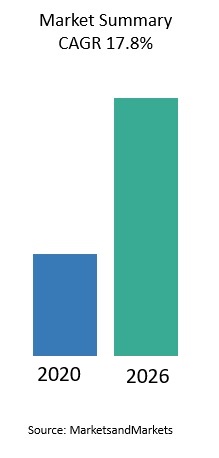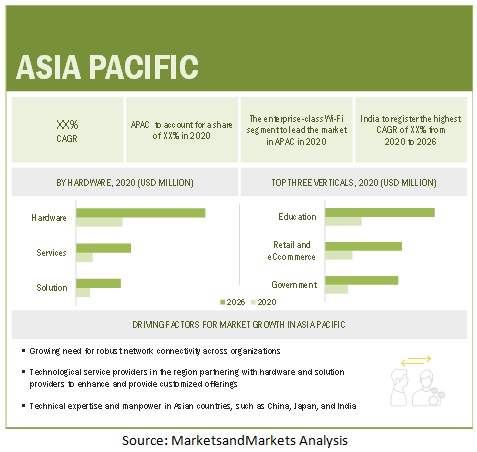< Key Hightlight >
The global Wi-Fi market size is projected to grow from USD 9.4 billion in 2020 to USD 25.2 billion by 2026, at a Compound Annual Growth Rate (CAGR) of 17.8 % during the forecast period. The major growth drivers for the market include increasing need for robust network connectivity and adoption of Wi-Fi solutions in various verticals such as education, healthcare and life sciences, and retail and eCommerce, BFSI, and IT and telecom.

To know about the assumptions considered for the study, Request for Free Sample Report
COVID-19 Impact Analysis on Wi-Fi Market
The COVID-19 pandemic has affected every segment of society, including individuals and businesses. The internet ecosystem has been playing a pivotal role all over the globe. Due to the COVID-19 pandemic, the dependency on online businesses has increased significantly. Various organizations across the globe, such as the Bill and Melinda Gates Foundation (BMGF) and Wellcome Trust, are also coming together to accelerate and strengthen the efforts to fight the COVID-19 pandemic.
Market Dynamics
Driver: Digital transformation initiatives in businesses, paving the way for Wi-Fi networks
The rapid rise in the adoption of digital solutions has paved the way for the growth of Wi-Fi market. Organizations across the globe are eagerly implementing technologically advanced applications across their verticals to engage customers in innovative and captivating ways; this raising the need for adequate quality of wireless network connectivity, such as Wi-Fi. Furthermore, to fulfill the needs of an organization to the fullest, these new applications must be deployed in an agile environment, leading to rapid and responsive development while keeping network performance and cost-effectiveness optimal. Wi-Fi network deployment helps enterprises rapidly build and connect business applications effectively. The Wi-Fi network also provides greater flexibility, scalability, reliability, and cost-effective benefits in connecting mission-critical business applications. Additionally, core industry sectors are keen on automating and digitalizing their business processes to streamline business operations and drive new business revenue opportunities.
Restraint: Contention loss and co-channel interference
Contention loss and co-channel interference are the key issues associated with Wi-Fi networks. Contention loss refers to poor network performance due to many clients converging on a single AP, whereas co-channel interference is caused when two or more access points use the same Radio Frequency (RF) channel, thereby affecting the network performance. It is a threat in some of the mature markets, such as North America, Europe, and some APAC countries. The regions already have well-established Wi-Fi networks, and implementing a new network may cause network mapping between the channels, thereby hindering the performance of the network. Moreover, the distribution of users along the access points would not be even, which would pose a problem in making decisions about the implementation of new access points.
Opportunity: Increasing demand for carrier Wi-Fi
The increasing demand for carrier Wi-Fi is one of the crucial opportunities present in the Wi-Fi market. The carrier-grade market is evolving at a rapid pace, as large volumes of wireless traffic are generated from smartphones and tablets via Wi-Fi networks. Many major telecom operators are investing heavily in the carrier market, as the cost involved in implementing the service is much less compared to the other services. With the advent of technologies, such as BYOD and IoT, most telecom providers are focusing on gaining huge benefits from carrier-grade Wi-Fi. The carrier Wi-Fi model also provides several additional benefits, such as tracking and packaging, compared to the Wi-Fi model. Carrier Wi-Fi providers track and analyze mobile and web data traffic to increase their revenue by offering the most suitable data and web access packages to their subscribers.
Challenge: Poor user experience in high-density environments
Various users experience a poor Quality of Experience (QoE) due to substandard access point performance or inaccurate network planning. Users, especially in large venues, such as stadiums, shopping malls, and midsized hotels, expect that the Wi-Fi network will be reliable, scalable, and easily configurable. It is very challenging to deliver constantly good and high-quality Wi-Fi services, as providers face several issues. The most common issues include the poor range between Wi-Fi access points; interference in the network from external sources, such as weather stations and cell towers; and signal blockage by concrete walls. Providers support cost rises, as they have to bear additional expenses to purchase extenders and repeaters.
Healthcare and Life Sciences vertical to grow at the highest CAGR during the forecast period
Wi-Fi market is segmented into education, healthcare and life sciences, transportation and logistics, retail and eCommerce, government, manufacturing, hospitality, and others. The healthcare and life sciences vertical uses Wi-Fi for the centralized management of data to increase the scalability and reliability of the services offered. In the healthcare and life sciences industry, cloud Wi-Fi services enable easy and secure access to the medical history and other critical information of patients from anywhere at any time. The healthcare vertical covers PHI and critical patient data. The advancements in cloud technology also provide cost-efficient and reliable cloud Wi-Fi services to healthcare providers. Several healthcare organizations have adopted cloud-based technology as it allows real-time exchange of healthcare information between healthcare organizations and patients with agility and quality, and at reduced costs.

To know about the assumptions considered for the study, download the pdf brochure
APAC to account for the highest CAGR during the forecast period
APAC countries are increasingly investing in Wi-Fi projects. The Wi-Fi market in APAC has been sub-segmented into China, Japan, India, and the rest of APAC. A rapidly growing customer base, due to the increasing prominence of SMEs, coupled with the reduction in TCO, is expected to drive the market growth in APAC. APAC is witnessing an upsurge in the adoption of smart devices and internet, mandating the need for reliable and secure internet connectivity. Moreover, as broadband and mobile infrastructures are improving in the Asia Pacific region, the mobile workforce and BYOD trend are also gaining momentum. These trends in the Asia Pacific region are expected to lead to the increased adoption of Wi-Fi technology, which is expected to fuel the growth of the Asia Pacific market. Being a developing region, the major concern of small and medium enterprises in the Asia Pacific region is the cost that they have to bear for the deployment of on-premises WLAN solutions.
This research study outlines the market potential, market dynamics, and key and innovative vendors in the Wi-Fi market include Cisco (US), Ericsson (Sweden), Extreme Networks (US), Huawei (China), Juniper Networks (US), Panasonic (Japan), Fortinet (US), NETGEAR (US), Aruba (US), Alcatel-Lucent Enterprise (France), D-Link (Taiwan), Broadcom (US), Airtel (India), Orange Business Services (France), Comcast Business (US), Vodafone (UK), Telstra (Australia), Fujitsu (Japan), AT&T (US), Lever Technology Group (UK), Redway Networks (Buckinghamshire), Ubiquiti Networks (US), iPass (US), Superloop (Australia), Cambium Networks (US), CASA Systems (US), Fon (Spain).
The study includes an in-depth competitive analysis of these key players in the Wi-Fi market with their company profiles, recent developments, and key market strategies.
Scope of the Report
Report Metrics | Details |
Market size available for years | 2015–2026 |
Base year considered | 2020 |
Forecast period | 2020–2026 |
Forecast units | Value (USD) |
Segments covered | Component (Hardware, Solutions, and Services), Density, Location Type, Organization Size, Verticals and Region |
Geographies covered | North America, Europe, APAC, MEA, and Latin America |
Companies covered | Cisco (US), Ericsson (Sweden), Extreme Networks (US), Huawei (China), Juniper Networks (US), Panasonic (Japan), Fortinet (US), NETGEAR (US), Aruba (US), Alcatel-Lucent Enterprise (France), D-Link (Taiwan), Broadcom (US), Airtel (India), Orange Business Services (France), Comcast Business (US), Vodafone (UK), Telstra (Australia), Fujitsu (Japan), AT&T (US), Lever Technology Group (UK), Redway Networks (Buckinghamshire), Ubiquiti Networks (US), iPass (US), Superloop (Australia), Cambium Networks (US), CASA Systems (US), Fon (Spain). |
This research report categorizes the Wi-Fi market to forecast revenues and analyze trends in each of the following subsegments:
Based on Component:
- Hardware
- Solutions
- Services
Based on Density:
- Hi-Density Wi-Fi
- Enterprise-Class Wi-Fi
Based on Location Type:
Based on Organization Size:
Based on Verticals:
- Education
- Healthcare and Life Sciences
- Transportation and Logistics
- Retail and eCommerce
- Government
- Manufacturing
- Hospitality
- Others (BFSI, Oil and Gas, Utilities, IT and Telecom, and Sports and Leisure)
Based on Region:
- North America
- Europe
- United Kingdom (UK)
- Germany
- France
- Rest of Europe
- APAC
- China
- Japan
- India
- Rest of APAC
- MEA
- Middle East
- Africa
- Rest of MEA
- Latin America
- Brazil
- Mexico
- Rest of Latin America
Recent Developments:
In 2021 January, Extreme Networks updated the launch of ExteremeWireless AP300C and AP400C. The product launches would give its channel the opportunity to get in front of customers and offer solutions that offered more depth and flexibility.
- In 2020 September, Ericsson acquired Cradlepoint, and the combined offering will create valuable new revenue streams for customers by supporting full 5G-enabled services for enterprise, and boost returns on investments in the network.
- In 2020 August, Juniper Networks announced four new wireless Aps – AP63, AP33, AP32, and AP12 that extend the benefits of AI-driven Wi-Fi 6 to additional verticals and use cases. From stores and schools to homes and hospitals, companies of all sizes and with a wide array of deployment requirements can now take advantage of the insight, automation, performance and actions uniquely delivered by the Juniper Mist wireless solution.
- In 2020 July, Ericsson partnered with Airtel, three-year partnership aims to transform existing operations with new capabilities introduced through Ericsson Operations Engine. Ericsson will deploy the latest automation, AI and ML technologies to enhance Airtel’s mobile network performance and customer experience.
- In 2020 February, Panasonic Avionics partnered with Tata group’s NELCO, and launched in-flight Wi-Fi services in India, with Vistara likely to be the first airline in the country to avail the facility.
Key Benefits of Buying the Report
The report would provide the market leaders/new entrants in this market with information on the closest approximations of the revenue numbers for the overall Wi-Fi market and its sub-segments. It would help stakeholders understand the competitive landscape and gain more insights to position their business and plan suitable go-to-market strategies. It also helps stakeholders understand the market's pulse and provides them with information on key market drivers, restraints, challenges, and opportunities.




